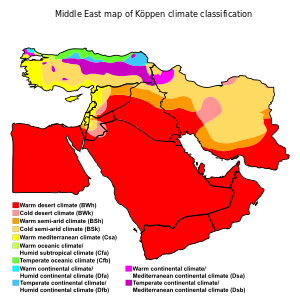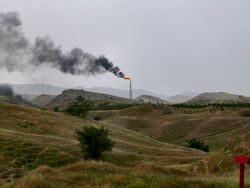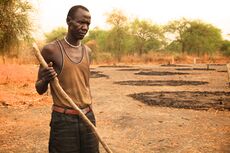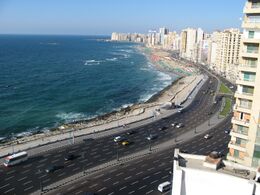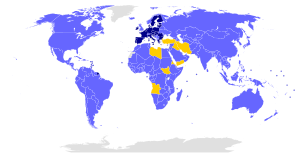التغير المناخي في الشرق الأوسط وشمال أفريقيا

التغير المناخي في الشرق الأوسط وشمال أفريقيا يشير إلى التغيرات في المناخ في الشرق الأوسط وشمال أفريقيا والاستجابة اللاحقة من البلدان في المنطقة واستراتيجيات التكيف والتخفيف البيئي .[1] في عام 2018، أصدرت منطقة الشرق الأوسط وشمال إفريقيا 3.2 مليار طن من ثاني أكسيد الكربون وأنتجت 8.7% من انبعاثات الغازات الدفيئة في العالم[2] برغم أنها تضم 6% فقط من سكان الأرض.[3] تصدر معظم هذه الانبعاثات من قطاع الطاقة،[4] وهو جزء لا يتجزأ من العديد من اقتصادات الشرق الأوسط وشمال إفريقيا بسبب الاحتياطيات الواسعة النفط والغاز الطبيعي الموجودة داخل المنطقة.[5][6] تعد منطقة الشرق الأوسط واحدة من أكثر المناطق عرضة لتغير المناخ. وتشمل الآثار زيادة في الجفاف الظروف والجفاف وموجات الحر و ارتفاع مستوى سطح البحر.
Sharp global temperature and sea level changes, shifting precipitation patterns and increased frequency of extreme weather events are some of the main impacts of climate change as identified by the Intergovernmental Panel on Climate Change (IPCC).[7] The MENA region is especially vulnerable to such impacts due to its arid and semi-arid environment, facing climatic challenges such as low rainfall, high temperatures and dry soil.[7][8] The climatic conditions that foster such challenges for MENA are projected by the IPCC to worsen throughout the 21st century.[7] If greenhouse gas emissions are not significantly reduced, part of the MENA region risks becoming uninhabitable before the year 2100.[9][10][11]
Climate change is expected to put significant strain on already scarce water and agricultural resources within the MENA region, threatening the national security and political stability of all included countries.[12] This has prompted some MENA countries to engage with the issue of climate change on an international level through environmental accords such as the Paris Agreement. Law and policy are also being established on a national level amongst MENA countries,[13] with a focus on the development of renewable energies.[14] قالب:TOC level
Greenhouse gas emissions
As of January 2021, the UNICEF website groups the following set of 20 countries as belonging to the MENA region: 'Algeria, Bahrain, Djibouti, Egypt, Iran (Islamic Republic of), Iraq, Jordan, Kuwait, Lebanon, Libya, Morocco, Oman, Qatar, Saudi Arabia, State of Palestine, Sudan, Syrian Arab Republic, Tunisia, United Arab Emirates, Yemen.'[15] Others include Israel as well.[16]
Greenhouse gas emissions produced by humans have been identified by the IPCC and the vast majority of climate scientists as the primary driver of climate change.[17][7] In the past three decades the MENA region has more than tripled its greenhouse gas emissions and is currently emitting above the global average per person, with most of the top ten countries by carbon dioxide emissions per person being found in the Middle East.[18][2] These high emissions levels can be primarily attributed to Saudi Arabia and Iran, which are the 9th and 7th largest emitters of CO2 in the world, accounting for 40% the regions emissions in 2018.[2] MENA countries heavily rely on fossil fuels for the generation of electricity, sourcing 97% of their energy from oil, natural gas, and coal (in Turkey).[19] Fossil fuel extraction, production and exportation is also a significant component of many economies within the MENA region, which possesses 60% of the world oil reserves and 45% of known natural gas reserves.[20] Reducing gas flaring would help.[21]
The failure of the Iranian subsidy reform plan during the 2010s left Iran as the world's largest subsidiser of fossil fuel in 2018.[22] But, unlike other countries which successfully removed subsidies by acting gradually, at the end of the decade the government attempted to suddenly reduce gasoline subsidies, sparking riots.[23][24]
Impacts on the natural environment
Temperature and weather changes
Heat extremes
The IPCC project average global temperatures to rise more than 1.5 degrees by the end of the 21st century.[7] MENA has been identified as a hotspot for future temperature changes due to its arid environmental conditions.[25] Whilst projected rates of warming during winter months are low, the region is expected to experience extreme temperature increases during summer.[26][27] Temperature rises are expected to be further amplified by reductions in rainfall and the associated depletion of soil moisture, limiting evaporative cooling.[28] As a result, heat extremes are expected to increase significantly in both frequency and intensity across the MENA region. According to studies published by the Max Planck Institute for Chemistry, the number of very hot days in the region has doubled between the 1970s and the time when the report was published (2016).[26] The study further projects that heatwaves will occur for 80 days of the year by 2050 and 118 days of the year by 2100.[26] Combined with increased sandstorms associated with longer drought periods, predicted temperature rises would make large parts of the region uninhabitable.[26]
The average maximum temperature during the hottest days of the past 30 years has been 43 degrees Celsius.[8] Dutch atmospheric chemist Johannes Lelieveld has projected that temperature maximum's could reach almost 50 degrees Celsius under current climate scenarios established by the IPCC.[28] Johannes Lelieveld further projects that average summer temperatures are expected to increase by up to 7% across the MENA region, and up to 10% in highly urbanised areas.[28] Extreme heat has been identified as a serious threat to human health, heightening an individuals' susceptibility to exhaustion, heart attack and mortality.[29] Climate scientist Ali Ahmadalipour has projected heat-related mortality rates within the MENA region to be up to 20 times higher than current rates by the end of the century.[30]
Water resources
The Middle East and North Africa currently faces extreme water scarcity, with twelve out of the 17 most water stressed countries in the world deriving from the region.[31] The World Bank defines an area as being water stressed when per person water supplies fall below 1,700 cubic metres per year.[32] The water supply across the MENA region is averaged at 1274 cubic metres per capita, with some countries having access to only 50 cubic metres per person.[12] The agricultural sector within the MENA region is heavily dependent on irrigation systems due to its arid climate, with 85% of fresh water resources being utilised for agricultural purposes.[33][34] The IPCC indicate that the global distribution of rainfall is currently shifting in response to increasing greenhouse gas emissions, with increases in high latitude and mid-latitude wet region and decreases in equatorial dry regions such as the MENA.[7] These shifting precipitation patterns have already placed significant strain on MENA agriculture, with the frequency and severity of droughts rising significantly in the past decade.[35]
A recent NASA study suggests that the 1998-2012 drought in the Middle East was the worst to occur in the past 900 years.[36] Climate scientist Colin Kelley suggests that climate change was a significant contributor to the increased severity of the most recent drought in the region. He claims that such drought is 3 times more likely to occur due to human influence on climate and the drought have contributed to the beginning of the Syrian civil war.[37] Along with environmental impacts, increasing drought periods affect agricultural incomes, diminishes public health and weakens political stability in the MENA region.[38] Syria experienced its most severe drought on record from 2007 to 2010, where restricted water supply degraded agricultural resources and increased economic pressures.[37][39] American environmental scientist Peter Gleick also asserts that heightened social vulnerability and conflict over scare water supplies during this period catalysed the onset of the Syrian war.[39]
However, in 2017 a study lead by sociologist and political ecologist Jan Selby has discredited these claims, reporting that there is no solid evidence that climate change is associated with the drought, the same about the impact of the drought on the conflict in Syria.[40] In 2019 Konstantin Ash and Nick Obradovich published research indicating that extreme drought was one of the leading factors in the creation of the Syrian war.[41]
Increasing water insecurity as a result of climate change is set to exacerbate existing food insecurities in the countries affected.[42] A study published by the World Food Porgramme has predicted a decline in crop yields by 30% in 2050 as a result of increasing droughts.[42] North African countries are highly vulnerable to reduced precipitation as 88% of the regions crops possess no irrigation, relying on consistent rainfall.[43] The consequences of these reduced harvests strongly impact rural regions and communities that rely heavily on agriculture as a source of income.[44]
Sea level rise
Alexandria is one of the most vulnerable cities to sea level rise.[9]
Across the MENA region, 60 million people inhabited coastal areas in 2010, a population that has been predicted by the World Bank to grow to 100 million by 2030.[12][45] As a result, the population of the MENA region is expected to be significantly impacted by sea level rise occurring due to climate change.[46] One consequence of rising sea levels is the loss of coastal wetlands, a natural resource responsible for ecosystem services such as storm buffering, water quality maintenance and carbon sequestration.[47] A study conducted by the World Bank predicts that the MENA region would lose over 90% of its coastal and freshwater wetlands if a one-metre sea level rise were to occur.[47]
In North Africa, Egypt is expected to be most affected by changes in sea level.[46] A third of the Nile Delta and large parts of Alexandria, Egypt's second largest city, lie below the mean global sea level.[48] These areas have been drained for agricultural purposes and undergone urban development, where inundation and flooding is prevented by sea walls and dams.[48] However, failures occurring in these structures, storm surges and extreme weather events could lead to the inundation of these areas in the future if sea levels continue to rise.[48] Agricultural areas in Egypt are particularly at risk, where a one-metre rise in sea level would submerge 12-15% of the nations total agricultural land.[49] This is estimated to displace 6.7 million people in Egypt and affect millions more who rely on agriculture for income.[49] A more moderate 50 cm increase in sea level has been projected to displace 2 million people and generate US$35 billion of damages.[50]
Mitigation and adaptation
The severe impacts of climate change on the region, made climate change mitigation and adaptation an important issue in it. Regional cooperation is considered as one of the main conditions for effective mitigation and adaptation[51][52]
الطاقة المتجددة
The MENA region possesses high potential for developing renewable energy technologies due to the high levels of wind and sunshine that are associated with its climate.[53] The International Renewable Energy Agency (IRENA) has identified over half of all land in GCC states as being suitable for the deployment of solar and wind technologies.[54] IRENA has also identified North African countries as having greater potential for wind and solar energy generation than all other regions of the continent.[55] Sourcing energy from renewable technologies instead of fossil fuels could significantly reduce energy related GHG emissions, which presently account for 85% of total emissions within the MENA region.[56][57] Renewable energy generation also involves significantly less water usage than processes associated with fossil fuel extraction and its conversion into usable energy, possessing the potential to improve water quality and availability within the region.[58][59] Renewable energy presently accounts for 1% of the total primary energy supply across the MENA region.[60]
At the 2016 UN Climate Change Conference in Marrakech, Morocco (COP22), Morocco, Tunisia, Yemen, Lebanon and the State of Palestine, along with 43 other countries, committed to deriving all energy from renewable resources by 2050.[61][62]
محطة الطاقة الشمسية في ورزازات
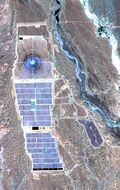
The Ouarzazate Solar Power Station is a solar power complex located in the Drâa-Tafilalet region of Morocco, and is currently the largest concentrated solar power plant in the world.[63] The complex consists of four separate power plants that utilise concentrated solar power and photovoltaic solar technology.[63] The project, costing US$2.67 billion, is expected to provide 1.1 million Moroccans with clean energy and reduce the country's carbon emissions by 700,000 tonnes every year.[64] The total energy capacity of the solar plant is expected to reach 2000 Megawatts by the end of 2020.[65]
السياسات والتشريعات
اتفاقية پاريس
Eleven countries from the MENA region attended the 21st Conference of the Parties of the UNFCCC where countries negotiated the Paris Agreement, an agreement with the United Nations concerning greenhouse gas emissions mitigation. اعتبارا من 2021[تحديث] Eritrea, Iran, Iraq, Libya, and Yemen are the only countries in the world which have not ratified the agreement.[66] Morocco has set its nationally determined contribution to a 17%-42% reduction in emissions and has set a target of having 52% of renewable energy in its total installed electricity production capacity by 2050.[67] The share of renewable energy reached 28% in 2018 and is currently recognised by the United Nations as being on track to achieving its renewable energy targets.[68] The UAE, despite ratifying the agreement, have set no reduction in emissions in their nationally determined contribution. The United Nations have identified their NDC target as "critically insufficient".[69]
خطة عمل المناخ للشرق الأوسط وشمال أفريقيا
In 2016 the World Bank put forth the MENA Climate Action Plan, a series of financial commitments centered around the redistribution of finance to the MENA region.[70] The World Bank deemed the plans core focus to be ensuring food and water security, increasing resilience to climate change impacts and improving investment in renewable energy source.[70] One of the Action Plan's major commitments was to allocate 18-30% of MENA finance towards climate related initiatives, which currently stands a $1.5 billion annually. The World Bank have also outlined a significant increase in funding directed towards adaptation initiatives such as water conservation and recycling, introduction of desalination facilities and investment into carbon sequestration technologies.[70]
حسب البلد
الجزائر
مصر
Egypt's Nile Delta is impacted by saltwater intrusion caused by sea level rise, leading to major implications for the country.[71] Agriculture and food security in Egypt will be disrupted by climate change due to increased drought, higher temperatures, extreme weather events, plant diseases and pests, with major infrastructure changes required to adapt.[72] Water security in Egypt will also be disrupted.[73][74]
إيران
This section requires expansion. (May 2020) |
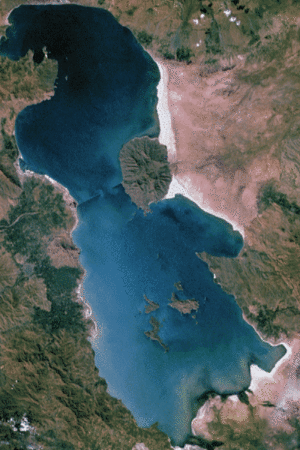
Iran is the largest greenhouse gas emitter not to have ratified the Paris Agreement.[76] Iran was estimated to emit 700 megatonnes of CO2 in 2019, about 8 and a half tonnes per person,[77] which was 1.85% of the world total. From 2009 to 2019, Iran's CO2 emissions rise from 11.97 million tons to 24.12 million tons.[78] Over 5 megatons of methane was emitted in 2020, which was over 7% of the world total.[79] From 2008 to 2018, Iran's methane emissions rose from 136,920 kilotons to 149,690 kilotons.[80]
Much of Iran's territory suffers from overgrazing, desertification and deforestation. Industrial and urban wastewater runoff has contaminated rivers, coastal and underground waters.[81] Wetlands and bodies of fresh water increasingly are being destroyed as industry and agriculture expand, and oil and chemical spills have harmed aquatic life in the Persian Gulf and the Caspian Sea. Iran contends that the international rush to develop oil and gas reserves in the Caspian Sea presents that region with a new set of environmental threats. Although a Department of Environment has existed since 1971, Iran has not yet developed a policy of sustainable development because short-term economic goals have taken precedence.[بحاجة لمصدر]
العراق
إسرائيل
This section requires expansion. (May 2020) |
According to the Ministry of Environmental Protection of Israel: "While Israel is a relatively small contributor to climate change due to its size and population, it is sensitive to the potential impacts of the phenomenon, due to its location. Thus, it is making an effort to reduce greenhouse gas emissions while simultaneously doing whatever possible to reduce the expected damage that will result if climate change is not halted."[82]
The impacts of climate change are already felt in Israel. The temperature rose by 1.4 degrees between 1950 and 2017. The number of hot days increased and the number of cold days decreased.[مطلوب توضيح] Precipitation rates have fallen. The trends are projected to continue. By the year 2050, in the coastal area the number of days with maximal temperature above 30 degrees, per year, is projected to increase by 20 in the scenario with climate change mitigation and by 40 in "business as usual" scenario.[83]
Israel ratified the Paris Agreement in 2016. The country is part of 3 initiatives on mitigation and adaptation and 16 other actions taken by non governmental organisations.[84]
According to Israel's Intended nationally determined contribution the main mitigation target is to reduce per capita greenhouse gas emissions to 8.8 tCO2e by 2025 and to 7.7 tCO2e by 2030. Total emissions should be 81.65 MtCO2e in 2030. In the business as usual scenario the emissions would be 105.5 MtCO2e by 2030 or 10.0 tCO2e per capita. To reach it, the government of Israel wants to reduce the consumption of electricity by 17% relative to the business as usual scenario, produce 17% of electricity from renewables and shift 20% of transportation from cars to public transport by 2030.[85] In an effort to comply with GHG emission reductions, Israel formed a committee with the goal of evaluating the country's potential to reduce emissions by the year 2030. Their findings have confirmed that Israel's power sector generates approximately half of the country's total GHG emissions. The second largest offender is the transport sector, which produces approximately 19% of total emissions.[86]
الأردن
الكويت
المغرب
تركيا
الإمارات العربية المتحدة
انظر أيضاً
للاستزادة
- Ide, Tobias (2018-12-01). "Climate War in the Middle East? Drought, the Syrian Civil War and the State of Climate-Conflict Research". Current Climate Change Reports (in الإنجليزية). 4 (4): 347–354. doi:10.1007/s40641-018-0115-0. ISSN 2198-6061.
- Sowers, Jeannie; Vengosh, Avner; Weinthal, Erika (2010-04-23). "Climate change, water resources, and the politics of adaptation in the Middle East and North Africa". Climatic Change. 104 (3–4): 599–627. doi:10.1007/s10584-010-9835-4. hdl:10161/6460. ISSN 0165-0009. S2CID 37329318.
المراجع
- ^ Olawuyi, Damilola (31 July 2021). Climate Change Law and Policy in the Middle East and North Africa Region (1st ed.). London: Routledge. pp. 1–340. ISBN 9780367490324. Retrieved 26 September 2021.
- ^ أ ب ت "CO2 Emissions | Global Carbon Atlas". www.globalcarbonatlas.org. Retrieved 2020-04-10.
- ^ "Population, total - Middle East & North Africa, World | Data". data.worldbank.org. Retrieved 2020-04-11.
- ^ Abbass, Rana Alaa; Kumar, Prashant; El-Gendy, Ahmed (February 2018). "An overview of monitoring and reduction strategies for health and climate change related emissions in the Middle East and North Africa region" (PDF). Atmospheric Environment. 175: 33–43. Bibcode:2018AtmEn.175...33A. doi:10.1016/j.atmosenv.2017.11.061. ISSN 1352-2310.
- ^ Al-mulali, Usama (2011-10-01). "Oil consumption, CO2 emission and economic growth in MENA countries". Energy (in الإنجليزية). 36 (10): 6165–6171. doi:10.1016/j.energy.2011.07.048. ISSN 0360-5442.
- ^ Tagliapietra, Simone (2019-11-01). "The impact of the global energy transition on MENA oil and gas producers". Energy Strategy Reviews (in الإنجليزية). 26: 100397. doi:10.1016/j.esr.2019.100397. ISSN 2211-467X.
- ^ أ ب ت ث ج ح IPCC, 2014: Climate Change 2014: Synthesis Report. Contribution of Working Groups I, II and III to the Fifth Assessment Report of the Intergovernmental Panel on Climate Change [Core Writing Team, R.K. Pachauri and L.A. Meyer (eds.)]. IPCC, Geneva, Switzerland, 151 pp.
- ^ أ ب El-Fadel, M.; Bou-Zeid, E. (2003). "Climate change and water resources in the Middle East: vulnerability, socio-economic impacts and adaptation". Climate Change in the Mediterranean. doi:10.4337/9781781950258.00015. hdl:10535/6396. ISBN 9781781950258.
- ^ أ ب Broom, Douglas. "How the Middle East is suffering on the front lines of climate change". World Economic Forum. Retrieved 4 February 2020.
- ^ Gornall, Jonathan (24 April 2019). "With climate change, life in the Gulf could become impossible". Euroactive. Retrieved 4 February 2020.
- ^ Pal, Jeremy S.; Eltahir, Elfatih A. B. (2015-10-26). "Future temperature in southwest Asia projected to exceed a threshold for human adaptability". Nature Climate Change. 6 (2): 197–200. doi:10.1038/nclimate2833. ISSN 1758-678X.
- ^ أ ب ت Waha, Katharina; Krummenauer, Linda; Adams, Sophie; Aich, Valentin; Baarsch, Florent; Coumou, Dim; Fader, Marianela; Hoff, Holger; Jobbins, Guy; Marcus, Rachel; Mengel, Matthias (2017-04-12). "Climate change impacts in the Middle East and Northern Africa (MENA) region and their implications for vulnerable population groups" (PDF). Regional Environmental Change. 17 (6): 1623–1638. doi:10.1007/s10113-017-1144-2. ISSN 1436-3798. S2CID 134523218.
- ^ Olawuyi, Damilola (31 July 2021). Climate Change Law and Policy in the Middle East and North Africa Region (1st ed.). United Kingdom: Routledge. pp. 3–21. ISBN 9780367490324. Retrieved 2 September 2021.
- ^ Brauch, Hans Günter (2012), "Policy Responses to Climate Change in the Mediterranean and MENA Region during the Anthropocene", Climate Change, Human Security and Violent Conflict, Hexagon Series on Human and Environmental Security and Peace, 8, Springer Berlin Heidelberg, pp. 719–794, doi:, ISBN 978-3-642-28625-4
- ^ "Middle East and North Africa". unicef.org. UNICEF. Retrieved 16 January 2021.
- ^ Nuno Santos & Iride Ceccacci (2015). "Egypt, Jordan, Morocco and Tunisia: Key trends in the agrifood sector" (PDF). fao.org. FAO. Retrieved 16 January 2021.
- ^ Cook, John; Oreskes, Naomi; Doran, Peter T; Anderegg, William R L; Verheggen, Bart; Maibach, Ed W; Carlton, J Stuart; Lewandowsky, Stephan; Skuce, Andrew G; Green, Sarah A; Nuccitelli, Dana (2016-04-01). "Consensus on consensus: a synthesis of consensus estimates on human-caused global warming". Environmental Research Letters. 11 (4): 048002. Bibcode:2016ERL....11d8002C. doi:10.1088/1748-9326/11/4/048002. ISSN 1748-9326.
- ^ "Fossil CO2 and GHG emissions of all world countries : 2019 report". op.europa.eu. 2019-09-26. Retrieved 2020-05-20.
- ^ menara. "The MENA Region in the Global Energy Markets". Menara Project (in الإنجليزية الأمريكية). Retrieved 2020-04-24.
- ^ Bridle, Richard, L. Kitson, and Petre Wooders. "Fossil-fuel subsidies: A barrier to renewable energy in five Middle East and North African countries." GSI Report (2014): 8-9.
- ^ Ghadaksaz, Hesam; Saboohi, Yadollah (2020-11-01). "Energy supply transformation pathways in Iran to reduce GHG emissions in line with the Paris Agreement". Energy Strategy Reviews (in الإنجليزية). 32: 100541. doi:10.1016/j.esr.2020.100541. ISSN 2211-467X.
- ^ "Iran: Largest Fuel Subsidizer in 2018". Financial Tribune. July 16, 2019.
- ^ "AP Explains: Iran gas price protests quickly turn violent". AP NEWS. 2019-11-18. Retrieved 2020-05-11.
- ^ "How Reforming Fossil Fuel Subsidies Can Go Wrong: A lesson from Ecuador". IISD (in الإنجليزية). Retrieved 2020-05-11.
- ^ Planton, Serge; Driouech, Fatima; Rhaz, Khalid EL; Lionello, Piero (2016), Sub-chapter 1.2.2. The climate of the Mediterranean regions in the future climate projections, IRD Éditions, pp. 83–91, doi:, ISBN 978-2-7099-2219-7
- ^ أ ب ت ث Lelieveld, J.; Proestos, Y.; Hadjinicolaou, P.; Tanarhte, M.; Tyrlis, E.; Zittis, G. (2016-04-23). "Strongly increasing heat extremes in the Middle East and North Africa (MENA) in the 21st century". Climatic Change. 137 (1–2): 245–260. Bibcode:2016ClCh..137..245L. doi:10.1007/s10584-016-1665-6. ISSN 0165-0009.
- ^ Bucchignani, Edoardo; Mercogliano, Paola; Panitz, Hans-Jürgen; Montesarchio, Myriam (March 2018). "Climate change projections for the Middle East–North Africa domain with COSMO-CLM at different spatial resolutions". Advances in Climate Change Research. 9 (1): 66–80. doi:10.1016/j.accre.2018.01.004. ISSN 1674-9278.
- ^ أ ب ت Lelieveld, J.; Hadjinicolaou, P.; Kostopoulou, E.; Giannakopoulos, C.; Pozzer, A.; Tanarhte, M.; Tyrlis, E. (2013-03-24). "Model projected heat extremes and air pollution in the eastern Mediterranean and Middle East in the twenty-first century". Regional Environmental Change. 14 (5): 1937–1949. doi:10.1007/s10113-013-0444-4. ISSN 1436-3798.
- ^ Nairn, John; Ostendorf, Bertram; Bi, Peng (2018-11-08). "Performance of Excess Heat Factor Severity as a Global Heatwave Health Impact Index". International Journal of Environmental Research and Public Health. 15 (11): 2494. doi:10.3390/ijerph15112494. ISSN 1660-4601. PMC 6265727. PMID 30413049.
- ^ Ahmadalipour, Ali; Moradkhani, Hamid (2020-03-23). "Drought and heat-stress mortality risks: Assessing the role of climate change, socioeconomic vulnerabilities, and population growth". EGU General Assembly Conference Abstracts: 21415. Bibcode:2020EGUGA..2221415A. doi:10.5194/egusphere-egu2020-21415. S2CID 234903239.
{{cite journal}}: CS1 maint: unflagged free DOI (link) - ^ "17 Countries, Home to One-Quarter of the World's Population, Face Extremely High Water Stress". World Resources Institute (in الإنجليزية). 2019-08-06. Retrieved 2020-04-24.
- ^ "International Decade for Action 'Water for Life' 2005-2015. Focus Areas: Water scarcity". www.un.org (in الإنجليزية). Retrieved 2020-04-24.
- ^ Joffé, George (2016-07-02). "The Impending Water Crisis in the MENA Region". The International Spectator. 51 (3): 55–66. doi:10.1080/03932729.2016.1198069. ISSN 0393-2729. S2CID 157997328.
- ^ Sowers, Jeannie; Vengosh, Avner; Weinthal, Erika (2010-04-23). "Climate change, water resources, and the politics of adaptation in the Middle East and North Africa". Climatic Change. 104 (3–4): 599–627. doi:10.1007/s10584-010-9835-4. hdl:10161/6460. ISSN 0165-0009. S2CID 37329318.
- ^ Hazell, P. B. R. (2001). Managing droughts in the low-rainfall areas of the Middle East and North Africa. International Food Policy Research Institute. OCLC 48709976.
- ^ Cook, Benjamin I.; Anchukaitis, Kevin J.; Touchan, Ramzi; Meko, David M.; Cook, Edward R. (2016-03-04). "Spatiotemporal drought variability in the Mediterranean over the last 900 years". Journal of Geophysical Research: Atmospheres. 121 (5): 2060–2074. Bibcode:2016JGRD..121.2060C. doi:10.1002/2015jd023929. ISSN 2169-897X. PMC 5956227. PMID 29780676.
- ^ أ ب Kelley, Colin P.; Mohtadi, Shahrzad; Cane, Mark A.; Seager, Richard; Kushnir, Yochanan (2015-03-02). "Climate change in the Fertile Crescent and implications of the recent Syrian drought". Proceedings of the National Academy of Sciences. 112 (11): 3241–3246. Bibcode:2015PNAS..112.3241K. doi:10.1073/pnas.1421533112. ISSN 0027-8424. PMC 4371967. PMID 25733898.
- ^ Haddadin, Munther J. (2001). "Water Scarcity Impacts and Potential Conflicts in the MENA Region". Water International. 26 (4): 460–470. doi:10.1080/02508060108686947. ISSN 0250-8060. S2CID 154814291.
- ^ أ ب Gleick, Peter H. (2014). "Water, Drought, Climate Change, and Conflict in Syria". Weather, Climate, and Society. 6 (3): 331–340. doi:10.1175/wcas-d-13-00059.1. ISSN 1948-8327. S2CID 153715885.
- ^ Selby, Jan; Dahi, Omar S.; Fröhlich, Christiane; Hulme, Mike (2017-09-01). "Climate change and the Syrian civil war revisited". Political Geography (in الإنجليزية). 60: 232–244. doi:10.1016/j.polgeo.2017.05.007. ISSN 0962-6298.
- ^ Ash, Konstantin Ash; Obradovich, Nick (25 July 2019). "Climatic Stress, Internal Migration, and Syrian Civil War Onset". Journal of Conflict Resolution. 64 (1): 3–31. doi:10.1177/0022002719864140. S2CID 219975610.
- ^ أ ب Devereux, Stephen (December 2015). "Social Protection and Safety Nets in the Middle East and North Africa" (PDF). Institute of Development Studies. 2015 (80). Retrieved 15 May 2020.
- ^ Mougou, Raoudha; Mansour, Mohsen; Iglesias, Ana; Chebbi, Rim Zitouna; Battaglini, Antonella (2010-11-17). "Climate change and agricultural vulnerability: a case study of rain-fed wheat in Kairouan, Central Tunisia". Regional Environmental Change. 11 (S1): 137–142. doi:10.1007/s10113-010-0179-4. ISSN 1436-3798. S2CID 153595504.
- ^ Verner, Dorte (2012). "Adaptation to a changing climate in the Arab countries : a case for adaptation governance and leadership in building climate resilience" (PDF). Mean Development Report. 1 (1). Retrieved 15 May 2020.
- ^ World Bank. 2011. Climate change adaptation and natural disasters preparedness in the coastal cities of North Africa : phase 2 : adaptation and resilience action plan –alexandria area (English). Washington, D.C. : World Bank Group. http://documents.worldbank.org/curated/en/605381501489019613/phase-2-adaptation-and-resilience-action-plan-alexandria-area
- ^ أ ب Dasgupta, Susmita; Laplante, Benoit; Meisner, Craig; Wheeler, David; Yan, Jianping (2008-10-10). "The impact of sea level rise on developing countries: a comparative analysis" (PDF). Climatic Change. 93 (3–4): 379–388. doi:10.1007/s10584-008-9499-5. hdl:10986/7174. ISSN 0165-0009. S2CID 154578495.
- ^ أ ب Blankespoor, Brian; Dasgupta, Susmita; Laplante, Benoit (2014-12-01). "Sea-Level Rise and Coastal Wetlands". Ambio (in الإنجليزية). 43 (8): 996–1005. doi:10.1007/s13280-014-0500-4. ISSN 1654-7209. PMC 4235901. PMID 24659473.
- ^ أ ب ت Baumert, Niklas; Kloos, Julia (2017), Anticipating Emerging Risks and Vulnerabilities from Sea Level Rise Induced Preventive Resettlement in Greater Alexandria, Egypt, Springer International Publishing, pp. 133–157, doi:, ISBN 978-3-319-45646-1
- ^ أ ب Sivakumar, Mannava V. K.; Ruane, Alex C.; Camacho, Jose (2013), Climate Change in the West Asia and North Africa Region, Springer Netherlands, pp. 3–26, doi:, ISBN 978-94-007-6750-8
- ^ El-Raey, M. (1997). "Vulnerability assessment of the coastal zone of the Nile delta of Egypt, to the impacts of sea level rise". Ocean & Coastal Management. 37 (1): 29–40. doi:10.1016/s0964-5691(97)00056-2. ISSN 0964-5691.
- ^ Shafi, Neeshad. "Can fighting climate change bring the Arab world closer together?". World Economic Forum. Retrieved 1 June 2020.
- ^ Climate Change, Water Security, and National Security for Jordan, Palestine, and Israel (PDF). Ecopeace Middle East. January 2019. Retrieved 1 June 2020.
- ^ Kahia, Montassar; Aïssa, Mohamed Safouane Ben; Lanouar, Charfeddine (2017). "Renewable and non-renewable energy use - economic growth nexus: The case of MENA Net Oil Importing Countries". Renewable and Sustainable Energy Reviews. 71: 127–140. doi:10.1016/j.rser.2017.01.010. ISSN 1364-0321. S2CID 157146704.
- ^ Ferroukhi, R., Khalid, A., Hawila, D., Nagpal, D., El-Katiri, L., Fthenakis, V. and Al-Fara, A., 2016. Renewable Energy Market Analysis: The GCC Region. International Renewable Energy Agency: Abu Dhabi, UAE.
- ^ IRENA (2015), Africa 2030: Roadmap for a Renewable Energy Future. IRENA, Abu Dhabi. www.irena.org/remap
- ^ Sims, Ralph E.H.; Rogner, Hans-Holger; Gregory, Ken (2003-10-01). "Carbon emission and mitigation cost comparisons between fossil fuel, nuclear and renewable energy resources for electricity generation". Energy Policy. 31 (13): 1315–1326. doi:10.1016/s0301-4215(02)00192-1. ISSN 0301-4215.
- ^ Charfeddine, Lanouar; Kahia, Montassar (2019). "Impact of renewable energy consumption and financial development on CO2 emissions and economic growth in the MENA region: A panel vector autoregressive (PVAR) analysis". Renewable Energy. 139: 198–213. doi:10.1016/j.renene.2019.01.010. ISSN 0960-1481. S2CID 115691794.
- ^ El-Katiri, Laura (2014). A Roadmap for Renewable Energy in the Middle East and North Africa. The Oxford Institute for Energy Studies. doi:10.26889/9781907555909. ISBN 978-1-907555-90-9.
- ^ Kondash, Andrew J; Patino-Echeverri, Dalia; Vengosh, Avner (2019-12-04). "Quantification of the water-use reduction associated with the transition from coal to natural gas in the US electricity sector". Environmental Research Letters. 14 (12): 124028. Bibcode:2019ERL....14l4028K. doi:10.1088/1748-9326/ab4d71. ISSN 1748-9326.
- ^ Poudineh, Rahmatallah; Sen, Anupama; Fattouh, Bassam (2018-08-01). "Advancing renewable energy in resource-rich economies of the MENA". Renewable Energy. 123: 135–149. doi:10.1016/j.renene.2018.02.015. ISSN 0960-1481. S2CID 115194162.
- ^ "Climate Vulnerable Forum Commit to Stronger Climate Action at COP22". Climate Vulnerable Forum (in الإنجليزية الأمريكية). 2016-11-18. Retrieved 2020-05-26.
- ^ "Marrakech High Level Meeting". Climate Vulnerable Forum (in الإنجليزية الأمريكية). 2016-11-18. Retrieved 2020-05-28.
- ^ أ ب Fares, Mohamed Soufiane Ben; Abderafi, Souad (2018). "Water consumption analysis of Moroccan concentrating solar power station". Solar Energy. 172: 146–151. Bibcode:2018SoEn..172..146F. doi:10.1016/j.solener.2018.06.003. ISSN 0038-092X. S2CID 126097241.
- ^ "Expansion of Morocco's Largest Solar Complex to Provide 1.1 Million Moroccans with Clean Energy". World Bank (in الإنجليزية). Retrieved 2020-05-29.
- ^ Bank, African Development (2019-06-05). "Morocco - Ouarzazate Solar Power Station Project II - ESIA Summary". African Development Bank - Building today, a better Africa tomorrow (in الإنجليزية). Retrieved 2020-05-29.
- ^ "United Nations Treaty Collection". treaties.un.org. Retrieved 2020-11-24.
- ^ "Morocco". www.ndcs.undp.org (in الإنجليزية). Retrieved 2020-04-24.
- ^ "Morocco | Climate Action Tracker". climateactiontracker.org. Retrieved 2020-04-24.
- ^ "Saudi Arabia | Climate Action Tracker". climateactiontracker.org. Retrieved 2020-04-24.
- ^ أ ب ت "World Bank Steps Up Climate Funding in Arab World". World Bank (in الإنجليزية). Retrieved 2020-04-06.
- ^ "Egypt's Nile Delta falls prey to climate change". Al Arabiya English (in الإنجليزية). 2010-01-28. Retrieved 2022-08-18.
- ^ Mahmoud, M. A. (2019), Negm, Abdelazim M., ed. (in en), Impact of Climate Change on the Agricultural Sector in Egypt, The Handbook of Environmental Chemistry, 74, Cham: Springer International Publishing, pp. 213–227, doi:, ISBN 978-3-319-95065-5, https://doi.org/10.1007/698_2017_48, retrieved on 2022-08-18
- ^ Mostafa, Soha M.; Wahed, Osama; El-Nashar, Walaa Y.; El-Marsafawy, Samia M.; Zeleňáková, Martina; Abd-Elhamid, Hany F. (January 2021). "Potential Climate Change Impacts on Water Resources in Egypt". Water (in الإنجليزية). 13 (12): 1715. doi:10.3390/w13121715. ISSN 2073-4441.
- ^ Omar, Mohie El Din Mohamed; Moussa, Ahmed Moustafa Ahmed; Hinkelmann, Reinhard (2021-03-01). "Impacts of climate change on water quantity, water salinity, food security, and socioeconomy in Egypt". Water Science and Engineering (in الإنجليزية). 14 (1): 17–27. doi:10.1016/j.wse.2020.08.001. ISSN 1674-2370. S2CID 233854697.
- ^ Shadkam, Somayeh; Ludwig, Fulco; van Oel, Pieter; Kirmit, Çağla; Kabat, Pavel (2016-10-01). "Impacts of climate change and water resources development on the declining inflow into Iran's Urmia Lake". Journal of Great Lakes Research (in الإنجليزية). 42 (5): 942–952. doi:10.1016/j.jglr.2016.07.033. ISSN 0380-1330.
- ^ "Greenhouse gas emission scenarios in nine key non G20 countries: An assessment of progress toward 2030 climate targets" (PDF).
- ^ "Iran - CO2 emission 2019". countryeconomy.com (in الإنجليزية). Retrieved 2021-03-18.
- ^ Ritchie, Hannah; Roser, Max (11 May 2020). "CO₂ and Greenhouse Gas Emissions". Our World in Data.
- ^ "Methane Tracker Database – Analysis". IEA (in الإنجليزية البريطانية). Retrieved 2021-01-21.
- ^ "Methane emissions (kt of CO2 equivalent) - Iran, Islamic Rep. | Data". data.worldbank.org.
- ^ "Environmental Problems Related to the Groundwater Contamination in Iran – Phoenix Project of Iran" (in الإنجليزية البريطانية). Retrieved 2022-08-16.
- ^ "Energy and Climate Change". Ministry of Environmental Protection. Retrieved 10 May 2020.
- ^ Ashekanazi, Shani (3 December 2019). "Climate change will hit Israel especially hard, study finds". Globes English. Retrieved 10 May 2020.
- ^ "Israel". Nazca. United Nations. Retrieved 3 February 2020.
- ^ The State of Israel. "ISRAEL'S INTENDED NATIONALLY DETERMINED CONTRIBUTION (INDC)" (PDF). UNFCCC. Retrieved 3 February 2020.
- ^ "TARGETING CLIMATE CHANGE IN ISRAEL: TOWARD PARIS AND BEYOND" (PDF). Israel Environment Bulletin (42). January 2016.
وصلات خارجية
- CS1 الإنجليزية الأمريكية-language sources (en-us)
- CS1 maint: unflagged free DOI
- CS1 الإنجليزية البريطانية-language sources (en-gb)
- Short description is different from Wikidata
- Articles with hatnote templates targeting a nonexistent page
- مقالات فيها عبارات متقادمة منذ 2021
- جميع المقالات التي فيها عبارات متقادمة
- Articles with broken excerpts
- Articles to be expanded from May 2020
- All articles to be expanded
- Articles with unsourced statements from August 2022
- جميع الصفحات التي تحتاج تنظيف
- مقالات بالمعرفة تحتاج توضيح from May 2020
- Portal-inline template with redlinked portals
- Pages with empty portal template
- Climate change by country and region
- Environment of the Middle East
- North Africa
- Climate change in Africa
- Regional effects of climate change
